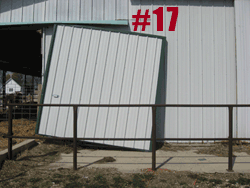 It may not seem like spring weather, but spring is here! That means it's time to clean, replace, and check on your equipment and facilities. David Bray at the University of Florida provided several items on this checklist for your dairy farm's spring cleaning list. While Florida's summer climate is different than other regions of the U.S., the same concept can be applied in your area.
It may not seem like spring weather, but spring is here! That means it's time to clean, replace, and check on your equipment and facilities. David Bray at the University of Florida provided several items on this checklist for your dairy farm's spring cleaning list. While Florida's summer climate is different than other regions of the U.S., the same concept can be applied in your area.1. Clean out high organic matter dirt (MUD) in pastures and lots and add new dirt, especially in calving areas.
2. Clean your barn cooling fans now and whenever they look dirty. Dirty fan shields can cut fan efficiency in half. This not only moves air to cool cows, it also helps to remove moisture and dry the place out.
3. Make sure your sprinklers, foggers, etc, work. It was a cold winter, and many pipes froze and/or broke. Dirty nozzles don't add much water. Check timers for the proper time for adding water. Constant water is not as efficient as intermittent sprinkling and saves water. Set your sprinkler thermostat at 75 degrees F or lower during the hot season. Sprinklers need to run at night because cows get hotter at night than daytime on those hot nights. You need timers to control sprinklers at night, so they only run when cows are eating and standing at the feed line. Running sprinklers when cows are in the stalls will waste great volumes of water and raise the humidity in the barn.
4. Clean and rebuild your pulsators. Wash out and change the filters on your vacuum controller (unless you have a variable-speed drive); make sure all ATOs work. Believe it or not, dealers do sell new pulsators.
5. Replace all milk hoses, wash hoses, pulsator hoses and jetter cup holders. Replace all rubber hoses in the milk house that may add water to the pipeline and /or bulk tank wash. These hoses harbor pseudomonas and coliforms and can raise your bacteria count. If rubber hoses are used to wash udders, change them, also.
6. Check every cow in the herd for blind quarters. Band the cows' legs so they are not milked. This will lower your SCC and SPC. Consider drying off or killing these quarters.
7. Replace all of your floor-mounted cow wash sprinkler nozzles once a year. Spring is a good time to do this. They not only clean cows; they cool cows also. Several short wash cycles are more efficient and use less water.
8. Check the pipeline and bulk tank chemical concentrations. If you change brands or suppliers, they may need to be checked. With new LPC concerns, this is important.
9. Clean your condenser fins on your milk coolers. Dirty fans cut down cooling and efficiency, and you get warmer milk at higher electric costs. If they are near a dusty area, concrete the area to keep the dust off the condensers.
10. Cull your chronic mastitis cows now. It will lower your cell count, and your help is sick of treating them.
11. Clean out the back third to half of your free stalls at least 10 to 12 feet deep and add new sand. Keep your stalls bedded every 4 to 5 days and groomed daily.
12. Clean out cooling ponds. Pump out the water, clean out the sludge, and spread it someplace where the cows do not have access to it.
13. Let ponds sit dry for the sun to work on the bacteria. Mycoplasma and other nasty stuff live in ponds. You must clean them out at least once a year if you continuously add water to the pond. If you DO NOT continuously add water, you need to sample the ponds for mycoplasma, and clean out the ponds once or twice during the summer.
14. Mow and spray careless weeds in all pastures; calves, heifers, dry cows.
15. Remove nonfunctioning machinery from working areas and disregard items that are no longer used or ineffective. Throw away (recycle) bale twine or feed sacks that may have accumulated over the winter.
16. Tidy the farm, remove fallen tree limbs, plant some flowers. Show the pride you have in your cows, your management, and your homestead.
17. Repair or fix any gates or doors that may have been damaged over the winter. It is a safety concern for animals and people. It also affects the public's perception of how you manage your operation.
18. Replace light bulbs, and check batteries for those needing to be changed.
19. Keep a stiff upper lip. If you made it through last year, you can make it through this year.
20. Clean out your mind, go visit other dairies. Some of them are doing amazing things and others are not. You can get new ideas or be glad you don't own some of them.
While it seems there is less time in each day to get the needed tasks completed, we do need to make the time to get actual and proverbial wheels greased, the batteries recharged, and a spit-shine on those boots so that your operation can run smoothly throughout the upcoming year. Whether you take one of these items or all 20 to task, it's a great way to embrace the new beginnings of spring!









